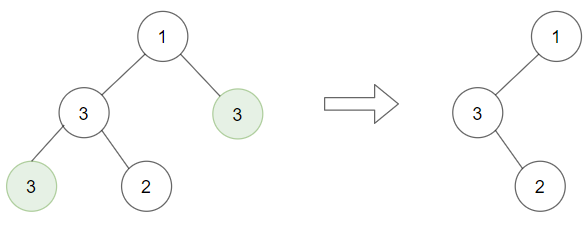Given a binary tree root and an integer target, delete all the leaf nodes with value target.
Note that once you delete a leaf node with value target, if it's parent node becomes a leaf node and has the value target, it should also be deleted (you need to continue doing that until you can't).
Example 1:
Input: root = [1,2,3,2,null,2,4], target = 2 Output: [1,null,3,null,4] Explanation: Leaf nodes in green with value (target = 2) are removed (Picture in left). After removing, new nodes become leaf nodes with value (target = 2) (Picture in center).
Example 2:
Input: root = [1,3,3,3,2], target = 3 Output: [1,3,null,null,2]
Example 3:
Input: root = [1,2,null,2,null,2], target = 2 Output: [1] Explanation: Leaf nodes in green with value (target = 2) are removed at each step.
Example 4:
Input: root = [1,1,1], target = 1 Output: []
Example 5:
Input: root = [1,2,3], target = 1 Output: [1,2,3]
Constraints:
1 <= target <= 1000- Each tree has at most
3000nodes. - Each node's value is between
[1, 1000].
Related Topics:
Tree
// OJ: https://leetcode.com/problems/delete-leaves-with-a-given-value/
// Author: github.com/lzl124631x
// Time: O(N)
// Space: O(H)
class Solution {
private:
TreeNode* postorder(TreeNode *node, int target) {
if (!node) return NULL;
node->left = postorder(node->left, target);
node->right = postorder(node->right, target);
return !node->left && !node->right && node->val == target ? NULL : node;
}
public:
TreeNode* removeLeafNodes(TreeNode* root, int target) {
return postorder(root, target);
}
};

